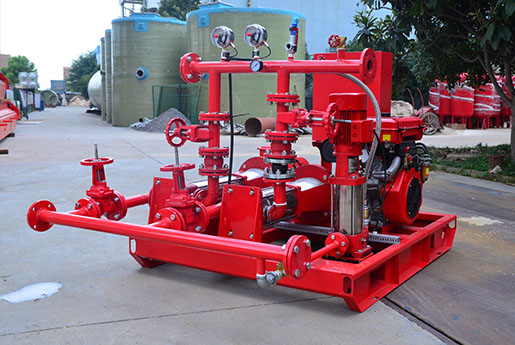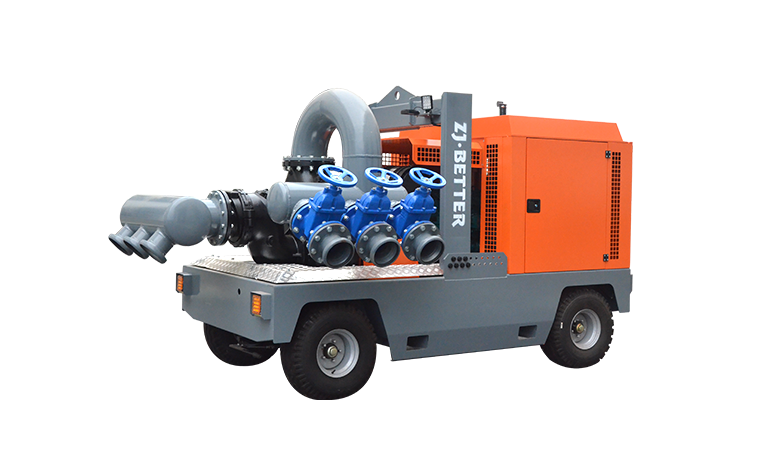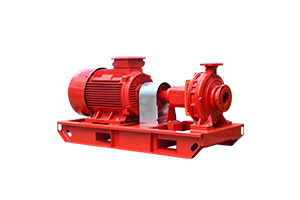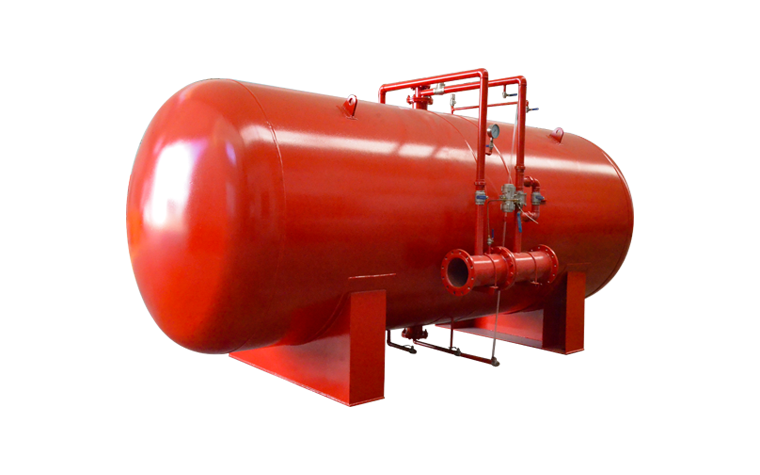-
 Aug 04, 2023What are the maintenance rules for fire pumps?Maintenance rules for fire pumps are essential to ensure that these critical systems remain in proper working condition to effectively protect lives and property. The following are general maintenance rules to consider for fire pumps:
Aug 04, 2023What are the maintenance rules for fire pumps?Maintenance rules for fire pumps are essential to ensure that these critical systems remain in proper working condition to effectively protect lives and property. The following are general maintenance rules to consider for fire pumps:
Follow Manufacturer's Guidelines:
Adhere to the manufacturer's recommended maintenance schedule, procedures, and guidelines. Manufacturers provide specific instructions for maintenance intervals and tasks based on the design and specifications of their pumps.
NFPA Standards Compliance:
Follow the maintenance requirements outlined in the relevant National Fire Protection Association (NFPA) standards, such as NFPA 20 (Standard for the Installation of Stationary Pumps for Fire Protection) and NFPA 25 (Standard for the Inspection, Testing, and Maintenance of Water-Based Fire Protection Systems).
Routine Inspection:
Conduct regular visual inspections of the pump, its components, and its surroundings. Look for signs of leaks, corrosion, loose connections, and other potential issues.
Lubrication:
Lubricate moving parts as per the manufacturer's recommendations. This includes bearings, shafts, and other components that require lubrication to reduce friction and wear.
Cooling System Maintenance:
Maintain the cooling system to prevent overheating. Clean cooling fins, ensure proper airflow, and address any issues with the cooling system promptly.
Electrical System Check:
Inspect electrical components, wiring, and connections. Test control panels and alarms to ensure they are functioning correctly.
Seal and Gasket Inspection:
Regularly check seals, gaskets, and packing for leaks or deterioration. Replace them if needed to prevent leaks that can affect the pump's performance.
Alignment and Vibration Monitoring:
Check for proper alignment of the pump and motor. Implement vibration monitoring to detect excessive vibrations that could indicate misalignment or mechanical issues.
Flow and Pressure Testing:
Regularly test the pump's flow and pressure performance to ensure it meets the specified requirements. This helps confirm that the pump is capable of delivering the necessary water volume for fire suppression.
Suction and Discharge System:
Inspect suction and discharge lines for obstructions, leaks, and blockages. Ensure proper valve operation and functionality.
Documentation and Record-Keeping:
Maintain thorough records of all maintenance activities, inspections, tests, and repairs. Documentation helps track the pump's history and facilitates compliance with regulations.
Training and Certification:
Ensure that personnel responsible for maintaining the fire pump are trained and certified in accordance with industry standards. Proper training ensures tasks are performed safely and effectively.
Emergency Preparedness:
Have a contingency plan in place to address pump failures during emergencies. Consider backup systems, redundancy, and emergency procedures.
Corrosion Control:
Take measures to prevent and control corrosion. Use corrosion-resistant materials and coatings to protect pump components from deterioration.
Remember that maintenance requirements can vary based on the type of fire pump (vertical turbine, horizontal split-case, etc.), the environment it operates in, and the regulations applicable in your region. Always refer to the manufacturer's guidelines and relevant industry standards for the most accurate and up-to-date maintenance rules for your specific fire pump system.
View details -
 Aug 04, 2023How to prolong the service life of fire pump?Prolonging the service life of a fire pump involves a combination of proper maintenance, regular inspections, and following best practices. Here are some key steps you can take to extend the service life of a fire pump:
Aug 04, 2023How to prolong the service life of fire pump?Prolonging the service life of a fire pump involves a combination of proper maintenance, regular inspections, and following best practices. Here are some key steps you can take to extend the service life of a fire pump:
Regular Inspections and Testing:
Conduct routine inspections of the fire pump according to the manufacturer's recommendations and industry standards. This can help identify any potential issues before they escalate.
Regularly test the pump's performance to ensure it's functioning within its specified parameters. This includes flow testing, pressure testing, and full-load testing.
Maintenance Schedule:
Develop a comprehensive maintenance schedule based on the manufacturer's guidelines and industry standards. This should cover routine tasks such as lubrication, cleaning, and inspection of various components.
Ensure that maintenance tasks are carried out by qualified personnel who are familiar with fire pump systems.
Lubrication and Cooling:
Keep the pump's bearings and moving parts well-lubricated according to the manufacturer's recommendations. Proper lubrication reduces friction and wear.
Maintain proper cooling to prevent overheating. Ensure that the pump's cooling system, if applicable, is functioning effectively.
Seal and Gasket Maintenance:
Regularly inspect seals and gaskets for signs of leaks or deterioration. Replace them promptly if any issues are detected. Leaks can lead to reduced efficiency and premature wear.
Cleaning and Corrosion Control:
Keep the pump and its surroundings clean to prevent dirt, debris, and contaminants from entering the system. Regular cleaning helps maintain optimal performance.
Address corrosion promptly. Corrosion can degrade components and reduce the pump's efficiency. Use appropriate corrosion-resistant materials.
Electrical System Maintenance:
Inspect and maintain the electrical components of the pump, including wiring, connections, and control panels. Ensure proper grounding and protection against electrical faults.
Suction and Discharge System:
Regularly inspect the suction and discharge lines for any obstructions, leaks, or blockages. These issues can impact the pump's performance and cause premature wear.
Vibration Monitoring:
Implement vibration monitoring systems to detect any abnormal levels of vibration, which could indicate misalignment or other mechanical issues.
Training and Documentation:
Ensure that personnel responsible for operating and maintaining the fire pump are adequately trained and knowledgeable about its proper use and maintenance.
Keep thorough records of all maintenance activities, inspections, and tests performed. This documentation can provide insights into the pump's history and help identify trends.
Emergency Preparedness:
Have a contingency plan in place in case of pump failure. This might involve backup systems, redundancy, and a clear plan for addressing pump failures during emergencies.
Remember that each fire pump system may have specific requirements based on its design and manufacturer. Regular communication with the manufacturer, adherence to industry standards (such as NFPA 25), and collaboration with qualified experts can further contribute to prolonging the service life of your fire pump.
View details -
 Aug 03, 2023Necessity of Purchasing Diesel Engine Fire Pumps for Fire Emergency RescuePurchasing diesel engine fire pumps for fire emergency rescue can offer several important benefits, but the decision ultimately depends on your specific circumstances, needs, and regulations. Here are some reasons why investing in diesel engine fire pumps might be necessary or beneficial for fire emergency rescue:
Aug 03, 2023Necessity of Purchasing Diesel Engine Fire Pumps for Fire Emergency RescuePurchasing diesel engine fire pumps for fire emergency rescue can offer several important benefits, but the decision ultimately depends on your specific circumstances, needs, and regulations. Here are some reasons why investing in diesel engine fire pumps might be necessary or beneficial for fire emergency rescue:
Reliability: Diesel engines are known for their robustness and reliability. In emergency situations, having a dependable fire pump that can operate reliably even if electrical power is compromised can be crucial.
Independence from Electrical Grid: Diesel engines can operate independently of the electrical grid, making them suitable for scenarios where power supply might be disrupted due to fires or other emergencies.
Immediate Response: Diesel fire pumps can provide immediate response to fire emergencies. They can start quickly and provide the required water pressure to firefighting systems without relying on external power sources.
Continuous Operation: Diesel engines can run for extended periods without interruption, as long as there's a sufficient fuel supply. This is important in situations where fires need to be controlled over an extended period of time.
Remote Locations: Diesel fire pumps are well-suited for locations where access to electricity might be limited, such as remote areas or construction sites.
Redundancy: Having diesel fire pumps as a backup to electric pumps can provide redundancy in case one system fails. Redundancy enhances the overall reliability of firefighting systems.
Regulatory Requirements: Depending on your industry and jurisdiction, regulatory requirements might mandate the presence of backup fire pumps for emergency response and safety.
Water Supply Challenges: In areas with inadequate water pressure or unreliable water sources, diesel fire pumps can ensure that sufficient water pressure is maintained for effective firefighting.
Large-Scale Fires: Diesel fire pumps are particularly useful for tackling large-scale fires where high water flow rates are required to control or suppress the fire effectively.
Versatility: Diesel fire pumps can be used in various settings, such as industrial facilities, construction sites, warehouses, and ships, making them versatile tools for emergency response.
Training and Familiarity: Many firefighting professionals are trained in operating diesel-powered equipment, making it easier to integrate diesel fire pumps into emergency response plans.
Long-Term Investment: While the upfront cost of purchasing diesel fire pumps might be higher, they can be a cost-effective long-term investment due to their durability and ability to function in a wide range of conditions.
It's important to note that while diesel engine fire pumps offer several advantages, they also require proper maintenance, fuel management, and adherence to safety protocols. The decision to purchase diesel engine fire pumps should be based on a comprehensive assessment of your organization's needs, risk factors, and compliance requirements. Consulting with experts in firefighting equipment and emergency management can help you make an informed decision that aligns with your specific goals and circumstances.
View details -
 Aug 03, 2023What should I pay attention to when using a diesel engine pump for the first time?Using a diesel engine pump for the first time requires careful attention to ensure proper operation, safety, and longevity of the equipment. Here are some important considerations to keep in mind:
Aug 03, 2023What should I pay attention to when using a diesel engine pump for the first time?Using a diesel engine pump for the first time requires careful attention to ensure proper operation, safety, and longevity of the equipment. Here are some important considerations to keep in mind:
Read the Manual: Familiarize yourself with the manufacturer's operation and maintenance manual. This will provide valuable information about the specific diesel engine pump model, its features, operating procedures, and maintenance requirements.
Safety Precautions: Prioritize safety at all times. Follow safety guidelines, wear appropriate personal protective equipment (PPE), and ensure that the area around the pump is clear of any hazards.
Inspection: Thoroughly inspect the diesel engine pump, including all components, connections, and hoses, to make sure everything is in proper working condition. Check for any signs of damage or leaks.
Fluid Levels: Check the fuel and oil levels to ensure they are at the recommended levels. Do not overfill or underfill these fluids.
Prime the Pump: If the pump requires priming, follow the manufacturer's instructions to ensure proper priming of the pump. This is crucial to prevent damage and ensure optimal performance.
Cooling System: Make sure the cooling system is functioning correctly. Check the coolant level and ensure that the cooling water is flowing properly to prevent overheating.
Starting Procedure: Follow the proper starting procedure outlined in the manual. This usually involves activating the ignition, engaging any necessary safety systems, and starting the engine. Be patient during the starting process and allow the engine to warm up before applying a load.
Load Application: If you're using the pump to move fluids, gradually apply the load to the pump. Sudden and excessive loads can cause stress on the engine and pump components.
Monitor Gauges and Instruments: Pay close attention to the engine's gauges, instruments, and alarms. Keep an eye on parameters like oil pressure, coolant temperature, and RPM to ensure they are within the recommended ranges.
Listen for Unusual Noises: During operation, listen for any unusual noises that could indicate mechanical issues. Any unfamiliar sounds should be investigated and addressed promptly.
Operate Within Limits: Stay within the recommended operational limits of the diesel engine pump. Avoid overloading or running the engine at excessively high RPMs.
Warm-Up and Cool-Down: Allow the engine to warm up before applying a load and let it cool down gradually after use. Avoid shutting off the engine immediately after heavy operation; allow it to run at low RPM for a few minutes to cool down.
Maintenance Schedule: Familiarize yourself with the recommended maintenance schedule outlined in the manual. Regular maintenance is crucial for the longevity and reliability of the diesel engine pump.
Documentation: Keep detailed records of the pump's usage, maintenance, and any issues encountered. This information will be valuable for troubleshooting and future maintenance.
Training: If you're not familiar with diesel engine pumps, consider receiving training or guidance from someone experienced in their operation before using one for the first time.
Remember that proper operation, maintenance, and care of the diesel engine pump will contribute to its efficiency, reliability, and overall lifespan. If you have any doubts or encounter issues, don't hesitate to consult the manufacturer's support or seek assistance from qualified professionals.
View details -
 Aug 02, 2023Layout of diesel pump roomThe layout of a diesel fire pump room can vary based on the vessel type, size, regulations, and the specific requirements of the vessel's classification society. However, I can provide you with a general outline of the components and considerations that might be found in a diesel fire pump room layout:
Aug 02, 2023Layout of diesel pump roomThe layout of a diesel fire pump room can vary based on the vessel type, size, regulations, and the specific requirements of the vessel's classification society. However, I can provide you with a general outline of the components and considerations that might be found in a diesel fire pump room layout:
Diesel Engines: The heart of the fire pump room is the diesel engine(s) that power the fire pump(s). These engines are typically installed on sturdy foundations and equipped with all necessary components for operation and maintenance.
Fire Pumps: The fire pumps, driven by the diesel engines, are responsible for supplying water to the vessel's firefighting systems. These pumps should be easily accessible for maintenance and inspection.
Piping and Valves: There will be a network of piping and valves connecting the fire pumps to the vessel's fire mains and other firefighting systems. These pipes and valves should be appropriately labeled for quick identification and operation during emergencies.
Fuel Storage and Supply: As the diesel engines require fuel to operate, provisions for fuel storage and supply should be present. This might include fuel tanks, filters, and fuel lines.
Ventilation: Adequate ventilation is crucial in a diesel fire pump room to ensure proper air exchange and cooling of the engines. Ventilation systems might include fans, vents, and exhaust ducts.
Electrical Systems: The fire pump room will require electrical systems for powering the diesel engines, pumps, and associated equipment. Electrical panels, switches, and wiring should be properly installed and protected.
Emergency Power: In the event of a power failure, it's important for the fire pump room to have access to emergency power sources to ensure the fire pumps can still function.
Fire Suppression and Detection: Fire detection and suppression systems might be installed within the fire pump room itself to provide an added layer of safety in case of an engine or fuel-related fire.
Fireproofing and Insulation: Fire pump rooms should be constructed with fire-resistant materials and insulation to contain any potential fires within the room and prevent the spread of flames.
Lighting: Adequate lighting should be provided to ensure visibility and safety within the fire pump room during routine maintenance and emergencies.
Access and Egress: The fire pump room should have clearly marked access points for personnel to enter and exit. Additionally, these access points should comply with safety regulations and provide a means of escape in case of emergencies.
Monitoring and Alarms: Monitoring systems should be in place to track the performance of the fire pumps, diesel engines, and other critical parameters. Alarms and notification systems should alert personnel to any malfunctions or issues.
Safety Equipment: Fire extinguishers, emergency showers, and other safety equipment should be strategically placed within the fire pump room for immediate use in case of an emergency.
Remember, the specific layout and design of the diesel fire pump room will be influenced by the vessel's characteristics and the regulations it needs to adhere to. Consulting with naval architects, marine engineers, and regulatory authorities will help ensure that the design meets all necessary requirements for safety and functionality.
View details -
 Aug 02, 2023Does the diesel engine fire pump room have to be an independent building?In the context of marine and ship systems, including fire pumps and engines, regulations and standards can vary depending on the specific maritime authority, classification society, and the type of vessel. Therefore, there isn't a definitive answer that applies to all situations. However, I can provide you with some general insights:
Aug 02, 2023Does the diesel engine fire pump room have to be an independent building?In the context of marine and ship systems, including fire pumps and engines, regulations and standards can vary depending on the specific maritime authority, classification society, and the type of vessel. Therefore, there isn't a definitive answer that applies to all situations. However, I can provide you with some general insights:
Regulations and Guidelines: Different maritime regulatory bodies and classification societies may have varying requirements for the location and design of fire pump rooms, as well as the placement of diesel engines used for fire pumps. These regulations might stipulate factors such as access, ventilation, fire protection, and separation from other spaces.
Independent Building: In some cases, regulations might require fire pump rooms to be housed in independent buildings or compartments to ensure their functionality and protection in case of a fire or other emergencies. An independent building can provide additional safety measures, such as insulation from potential fire sources or flooding.
Co-location: Depending on the vessel's design and regulatory framework, fire pumps and diesel engines might be located in the same space, especially on smaller vessels or those with space limitations. In such cases, strict fireproofing and safety measures would likely be required to prevent the spread of fire or smoke to the engine components.
Safety and Accessibility: Regardless of whether the diesel engine fire pump room is housed in an independent building or not, it's crucial to ensure that the room is easily accessible, adequately ventilated, and properly maintained to guarantee the fire pump's operational readiness at all times.
To determine whether a diesel engine fire pump room needs to be an independent building, you should consult the relevant maritime regulations and guidelines applicable to your specific vessel type and jurisdiction. Maritime authorities, classification societies, and naval architects with expertise in ship design and safety can provide accurate and up-to-date information based on your specific context.
View details

.png)
.png)

.png)


